If you drive to the very edge of Oregon and then get out and walk, you can stand where developers built Bayocean, what they called the “Atlantic City of the West.”
It rose up in the early 1900s on a narrow sand spit that forms the western edge of Tillamook Bay.
Built at a time when the West Coast was clamoring for the refined lifestyle of the Eastern Seaboard, Bayocean had a hotel, a bowling alley, a neighborhood of homes and even a small railroad. But then, in what amounts to a slow-motion disaster, it was swept away.
Watch: ‘Lost City of Bayocean'
In the 1950s, the fate of Bayocean was known by just about every Oregonian. The mere mention of the town conjured images of abandoned buildings, thievery, broken dreams and civilization reclaimed by the sea.
But now we’ve mostly forgotten and Bayocean comes as news to many Oregonians.
Take longtime Portland resident Jerry Sutherland. In his free time he hiked the coast, along a pristine spit of land that protects Tillamook Bay from the Pacific Ocean. There was nothing for miles except for dunes, scotch broom and fresh air. Then when he retired from his job installing air-conditioning, Sutherland had time to stop off at the nearby Tillamook County Pioneer Museum, where he learned that under that spit, lay the remains of an entire town.
"It was amazing," said Sutherland, who’s writing a history of Bayocean.
Giving a tour on the spit, he stops next to an old telephone pole with a sign saying, “Bayocean Town site 1906 to 1971.”
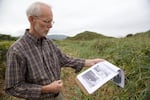
Historian Jerry Sutherland looks at old pictures of Bayocean as he walks the dunes in search of the town that used to stand under his feet.
Kristian Foden-Vencil / OPB
Back in the early 1920s Sutherland said, he would have been looking at an entire street with homes, paved streets with sidewalks and a pier that extended almost a quarter-mile into the bay.
“Looking across the street to the south would have been the general store, run by Francis and Ida Mitchell,” Sutherland said. “And then across the street was the Bayside Inn.”
Now it's just bushy trees and salal.
Sutherland thinks the whole place is an archeologist's dream.
“A little bit uphill you’d probably find old automobiles parked, rotting away. And some refrigerators, water heaters, whatever was left behind when this became an island."
But how did it all happen?
A developer’s son’s Tillamook vacation
Back in 1906 life in America was good. Electric lights were spreading across the country. Inventors were patenting vacuum cleaners, air conditioners and airplanes. And into this booming atmosphere walked 19-year-old Thomas Irving Potter, the son of a wealthy real-estate developer.
Potter was vacationing at Tillamook Bay. He was intrigued by the scenic, four-mile spit.
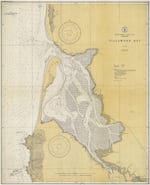
This map shows Tillamook Bay prior to the building of jetties.
Courtesy of NOAA's Office of Coast Survey Historical Map & Chart Collection
"The story goes that he shot a goose while target practicing with a .32 caliber revolver that he’d just acquired. Being escorted around Tillamook Bay in a boat, by some unnamed pioneer," explained Sutherland.
"When the goose dropped into the highest dune of the spit, he hiked up to retrieve it and fell in love with the place.”
The spit was long and narrow. At some points there was perhaps only a football field of width between the Pacific Ocean and Tillamook Bay. At other spots it was 150 feet high.
"From the high ridge line that ran down the southern portion of the spit, you could see both the bay on one side and the ocean on the other,” Sutherland said.
Potter immediately understood the appeal of a city with views of the roaring Pacific to the west and a pristine bay to the east. It may have reminded him of a miniature San Francisco.
Potter’s family had already developed subdivisions in California, Kansas City and Portland. The family business bought the legal rights to the original homesteads on the spit and formed a real estate company.
The Potters named their development "Bayocean Park" and starting drawing up big plans. There was to be a grand hotel, a swimming pool and a boardwalk. The idea was that as people bought lots, the Potters would build new amenities and the town would grow.

The town had all kinds of amenities — a pier, an amusement arcade, a store, a hotel — to attract vacationers circa 1910.
Courtesy of the Culp family / Eckhardt Collection
“Their first advertisements were promoting Bayocean as equivalent to Hotel Del Monte down in California, which was the place of the day,” Sutherland said.
Building on sand was not a concern back then. East coast towns like Atlantic City had been built on sand, and it was only seven feet above sea level.
Also, it probably wouldn’t have occurred to the Potters to ask the local tribes about the history of the land. But if the Potters had, they would have learned parts of the spit had a habit of being swept away and reappearing.
Attracting investors
But the Potters forged ahead.
The first step in attracting investors was to build a dock and four miles of infill for a new street, Bayside Boulevard. They also built employee housing , an administration building, an amusement arcade, a store and a bowling alley.
There was even a natatorium. This heated saltwater swimming pool had a wave machine that offered bathers the illusion of frolicking in a pleasantly warm Pacific Ocean.

The natatorium, down by the beach, had heated salt water and a wave machine.
Oregon Historical Society
The Potters were selling that era’s version of the American dream. Father would work in Portland during the week while mother and the children summered in the family’s very own Bayocean vacation home.
The Potters advertised in large cities across the West and sprinkled the society pages with accounts of wealthy couples vacationing in Bayocean.
Enough of the resort had been built by 1911 that there was a buzz and buyers started building summer cottages.
But there was a problem. There was no good road from Portland and the long-promised railroad was still under construction.
Arriving in style
So the Potters came up with their own elegant solution, a 130-foot wooden yacht with three steam-powered engines and masts adorned with colorful flags. As opposed to a two-day trip on a sternwheeler, it was capable of transporting vacationers in style from Portland along the Columbia River and down the coast to Tillamook Bay in just 12 hours.

This photo of the Bayocean motor yacht was taken sometime between May 27, 1911, when the yacht was launched in Portland, Oregon, and May 21, 1913, when this image was published in the San Francisco Call.
PDXhistory.com
But it was not always smooth sailing. Navigating the bars where the mighty Pacific met the turbulent waters of both the Columbia River and Tillamook Bay could delay the excursion for days.
Finely dressed vacationers could find themselves clinging to the rails, drenched in salty spray, fighting back nausea.
So the Potter family came up with another fix — and this is where many think the fate of Bayocean was sealed.
The Potters joined the push to get a jetty built to help calm the waters at the bay's entrance. Lumbermen from Portland wanted to build mills in the Tillamook area that could ship their cargo on bigger vessels. A more stable channel also meant safer crossings for fishermen.
The promise of greater economic activity helped spur the U.S. Army Corps of Engineers into action. Surveys were conducted and experts consulted. The Corps recommended a dual-jetty system to make the crossing safe and to protect against shifting sand. But the $2 million price tag was a lot of money in turn-of-the-century Tillamook. When it came time to vote on the idea, there was only enough political will to build one jetty.
“The Corps was reluctant since they'd never done that before,” Sutherland said. “They couldn’t come up with any evidence showing that there would be a negative result if they only built one.”
So despite the Corps’ misgivings, it went with the plan to build only a north jetty.

The North Jetty under construction in 1915 as seen from Barview.
Courtesy Garibaldi Maritime Museum.
The jetty was finished in 1917. It calmed the waters and enhanced Bayocean’s reputation as a desirable summer holiday destination.
These were the golden years for Bayocean. More and more families started vacationing there. By 1914, some 1,600 sites had been sold and homes were going up.
Small problems at first
But as with many catastrophes, the problems at Bayocean started small and took time to gather momentum.
One summer in the late 1920s, two families arrived to find their vacation cabins had fallen into the sea. The ocean had eaten away part of the dune they were built on. History writer Jerry Sutherland said the community wrote it off as the natural result of a strong winter storm.
In August 1928, a road finally linked Bayocean to the outside world.
"There was a grand celebration. The local newspaper reported 1,000 cars and 3,000 to 5,000 people came to celebrate. That would have been the largest gathering of people on Bayocean in all time," said Sutherland.
That milestone was the result of quiet but mighty forces in the background. Bayocean's seaward currents were being altered by the new jetty. Day after day, month after month, sand was being washed away from the shoreline. Though nobody knew it on that sunny August weekend, Bayocean was destined to shrink — not grow.
Donny Meyers was a young boy when he moved to Bayocean in the 1940s. His father worked for the local logging company so they weren’t in Bayocean for a vacation.
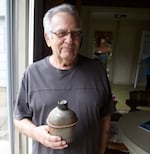
Donny Meyers spent his childhood living in Bayocean. He remembers finding all kinds of flotsam and jetsam on the beach, including a U.S. Marines water bottle.
Kristian Foden-Vencil / OPB
Meyers said in the winter there were only a couple of dozen families living on the spit. But in the summer, the population swelled to a couple of hundred. He remembers watching vacationers dig for clams.
“There was a quicksand hole out there. And we had a big long rope. ... We’d wait for them to come in with their clams and stuff. And they’d get in about up to their hips, and they couldn’t get out, and we’d yell at them and tell them that we’d throw them a rope, for a dime, or whatever and we’d pull them out of there,” laughed Meyers.
He remembers making good pocket money digging sand shrimp and selling them to the tourists for fishing bait.
Sliding away
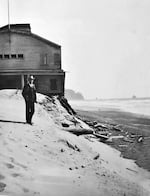
By 1926 the sand under the natatorium was beginning to be washed away.
US Army Corps of Engineers
Meanwhile, the ocean kept dragging away sand. By 1926, the ocean had started undermining the foundation of the natatorium. People were starting to worry.
Alarming stories and pictures of the pool’s foundation hanging precariously off the edge of the sand began showing up in newspapers.
Some families acted quickly, dragging their homes away from the edge of the dunes. Others decided to cut their losses completely and sell.
The Hicks House is one of those homes. It now sits several miles inland after being moved from Bayocean in 1952.
“They jacked it all up. There’s pictures, historical pictures of them having it on the back of a pickup truck, pulling it. They cut it in half with a chainsaw,” said Kristin Munsell, who now lives in the house. The sections of house were floated up the Tillamook River to where it sits now.
Munsell said there are still people around Tillamook, like Donny Meyers' playmate Perry Reeder, who visited her house when it was in Bayocean.
“The butlers would never let him in because this was considered a higher-status house. And they’d have to wait outside for the children who lived in here to play,” Munsell said.
Few families had the money to buy a house and move it inland. Also, panic had not set in. People knew it was not unusual for the ocean to sweep sand away one year, then replace it the next.

Kristin Munsell lives in the Hicks House, which was dragged seven miles inland after Bayocean started washing away.
Kristian Foden-Vencil / OPB
Then the crash
It took the 1929 stock market crash to really predict the end of Bayocean. The Great Depression meant nobody was going on holiday to places like Bayocean anymore, let alone building vacation homes. Interest in the town dried up overnight.
Meanwhile, more homes were swept away. By the mid ‘30s, the natatorium was a pile of rubble. The hotel annex had been stripped bare of anything usable. The peninsula's once-pristine sand was littered with ruined concrete foundations.
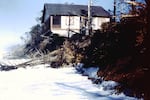
A storm in 1945 ate away at the dunes underpinning this home near Cape Meares.
From the Bonnie Lawrence collection, a Buck Sherwood photo.
Donny Meyers' whole childhood was set against this creeping catastrophe.
“Everybody lost just about everything," he said.
Meyers remembers the thievery.
“They’d take ... whatever they wanted. I think the last time I went in there with my Dad … there was lots of stuff still in the cabins. Washbasins and the pitchers,” said Meyers, who left the family house in the 1950s.
Bayocean was being gradually swept away, wave by wave. Storms broke through the spit in the late 1930s, tearing out sections of the only road to the mainland. Still, nobody knew how much of the town would be lost, and there were long pauses in the erosion, neglect and thievery. One of these pauses, ironically, was during World War II.
To protect the coast from foreign invasion, the government built the Naval Air Station Tillamook not far from Bayocean. That meant that for a few years the now ramshackle town’s population rebounded as workers rented empty cottages on the cheap.
The owner of a real estate office, general store and hotel, Francis Drake Mitchell, instigated a “Watch Bayocean Grow” campaign, which brought in a few newcomers with no memories of erosion.
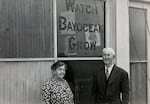
Francis Drake Mitchell — the owner of a real estate office, general store and hotel — started a “Watch Bayocean Grow” campaign. It was later spoofed as ‘Watch Bayocean G O.’
Courtesy of Margie and Dale Webber
For young Donny Meyers, it was an idyllic time. He remembers playing with the Coast Guard’s patrol dogs and walking the beaches, finding empty life rafts and boxes of powdered milk.
One day, he said his friend Jessie Mason figured out the dunes were still high enough to stand on top and contact the blimp pilots overhead.
“And they’d fly over low enough that they could hear him yelling at him through this megaphone. And they’d throw us down Hershey bars and candy bars and stuff,” said Meyers.
But after the war, Bayocean's reprieve was lifted. In 1948, a big storm worsened existing gaps in the spit, making the road at times impassable. Locals tried to fix it with driftwood pilings and hand shovels. But for many, the handwriting was on the wall: one trickster covered a couple of letters in F.D. Mitchell's promotional sign so it read "Watch Bayocean G O."
Marooned on an island
In November 1952 a powerful storm tore through the south end of the spit, opening up a half-mile wide gap. The ocean rushed in. Bayocean was no longer at the end of a peninsula. It was marooned on an island.
But instead of building a south jetty, the U.S. Army Corps of Engineers proposed a structure known as a breakwater, essentially a raised levee meant to stop the sea from flowing into Tillamook Bay.
“The breakwater was constructed in 1956. It was considered a priority above the south jetty because when that breach happened, the areas interior to Tillamook Bay were being affected,” explained coastal engineer Heidi Moritz of the Army Corps.
Once the 1952 storm broke through the narrow isthmus, tons of sand began washing into the bay through the gap, smothering the treasured local oyster beds, breaching lowland levees and sending brackish water into Tillamook's dairyland.
The construction of the breakwater stabilized the situation for Tillamook's industries; however, it took four years to build it. During that time, Bayocean was wiped out for good. Most of what remained was burned, bulldozed and buried under 10 feet of sand.
A garage was the last Bayocean building to fall into the ocean. It gave way slowly, but was mostly gone by 1971. That was just two years after the U.S. Army Corps started work on a second jetty, which would be completed in 1979. Since then, the shoreline of Bayocean has returned. The island is now a spit again.
What the native people knew
It’s poignant perhaps that nothing about Bayocean would have surprised the few tribal members still living around Tillamook at that time.
Their oral traditions tell of a god-like character, South Wind, whose phallus is the sand spit. He does noble things, like distributing berries across the land for people.
But Portland State University anthropology professor Doug Deur, said South Wind also does some negative things that result in his phallus being severed from time to time.
“It describes him chasing after, attempting to fornicate with a woman who is too young for him. And being punished essentially and so he gets stuck as the tide is rising and has to have it severed,” Deur explained.
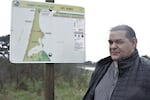
Oregon State University anthropologist David Lewis thinks tribal members probably advised Bayocean developers about the instability of the spit. But nobody listened.
Kristian Foden-Vencil / OPB
So tribes knew the spit had been an island in the past.
David Lewis is an anthropologist with Oregon State University and a member of the Confederated Tribes of the Grand Ronde. He thinks some of the Native Tillamooks may have warned Bayocean families about erosion issues.
“I mean it was a very racial time period, where native people were not really listened to very much," Lewis said. "Even if they had said something, they probably wouldn’t have been listened to."
And he thinks maybe that’s what we can learn from the story of Bayocean — to read the environment when making future plans.
For example, Lewis said tribes tended to build their villages close to resources, like a forest. But they didn’t build in the middle of the forest, because of wildfire. Lewis said there are many examples.
“I think when they saw the community of Champoeg set up on the Willamette River, they were kind of laughing because their houses were above the river maybe on a rise. They knew that at some point, there’d be a massive flood in the valley that would wipe out Champoeg, which actually did happen in 1861," Lewis said.
With tragedies like Champoeg and Bayocean in its history, Oregon has plenty of lessons to learn about working with nature. The next few years should show whether we’ve learned those lessons as we deal with climate change while making development decisions on everything from wind farms to urban expansion. And whatever we do, we’ll be providing lessons — positive or negative — for future generations.